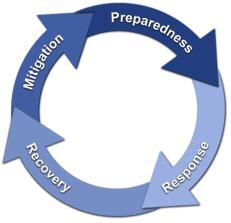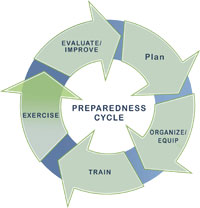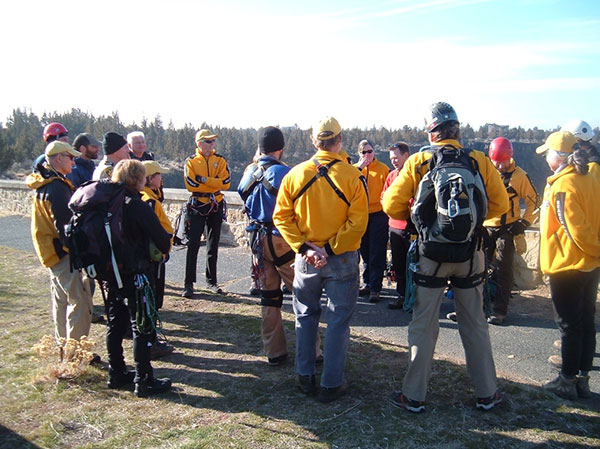About Emergency Management
What is Emergency Management?
Emergency management is the organized analysis, planning, decision-making, and assignment of available resources to mitigate, prepare for, respond to, and recover from the effects of all hazards.
The Goals of Emergency Management are to:
- Save Lives
- Prevent Injuries
- Protect Property and the Environment
Who is in charge of Emergency Management in Deschutes County?
Oregon law, under Oregon Revised Statute 401.305, declares that, “Each county of this state shall, and each city may, establish an emergency management agency which shall be directly responsible to the executive officer or governing body of the county or city".
In Deschutes County, the overall emergency management responsibility rests with the Deschutes County Sheriff. The responsibility to oversee the Emergency Management program has been delegated to an appointed Emergency Manager. The Emergency Manager is not person in charge of a response to a disaster …instead, this position is responsible for coordinating the plans of the various components of the emergency management system prior to the incident, and during an emergency, assist in coordination and support of the incident with:
- Fire and police,
- Emergency medical services,
- Public works,
- Volunteers, and
- Other groups contributing to the community’s management of emergencies.
Emergency management seeks to promote safer, less-vulnerable communities with the capacity to cope with hazards and disasters. It protects communities by coordinating and integrating all activities necessary to build, sustain, and improve the capability to mitigate against, prepare for, respond to, and recover from threatened or actual natural disasters, acts of terrorism, or other man-made disasters.
The four primary phases of Emergency Management

1. MITIGATION: Preventing future emergencies or minimizing their effects
- Mitigation includes any activities that prevent an emergency, reduce the chance of an emergency happening, or reduce the damaging effects of unavoidable emergencies
- Buying flood, earthquake and fire insurance for your home is a mitigation activity
- Actions may include continual assessment (risk analysis, vulnerability), public education and insurance, building codes, ordinances etc.
- Mitigation activities take place before and after emergencies
2. PREPAREDNESS: Preparing to handle an emergency
 Includes plans or preparations made to save lives, protect property and to help response and rescue operations
Includes plans or preparations made to save lives, protect property and to help response and rescue operations- Evacuation plans and stocking food and water, or developing a 72-hour kit are examples of preparedness
- Preparedness activities may include:
- Training for various disaster response personnel
- Conducting exercises to test plans and responses
- Writing Standard Operating Procedures or an Emergency Operation Plan
- Developing Mutual aid agreements
- Preparedness activities take place before an emergency occurs
3. RESPONSE: Responding safely to an emergency
- Includes actions taken to save lives and prevent further property damage in an emergency situation. Response is putting your preparedness plans into action
- Seeking shelter from a tornado or turning off gas valves in an earthquake are both response activities
- Opening Red Cross Shelters
- Response activities take place during an emergency

4. RECOVERY: Recovering from an emergency
- Includes actions taken to return to a normal or an even safer situation following an emergency
- Recovery includes getting financial assistance to help pay for the repairs
- Actions may include:
- Performing damage assessments
- Crises counseling
- Debris clearance
- Resolving health issues
- Requesting State and/or federal assistance
- Recovery activities take place after an emergency

What are the hazards in Deschutes County?
While Central Oregon residents and visitors to our area will never have to face the threat of a tsunami or hurricane locally, there ARE a number of natural events that could pose a natural disaster threat to Deschutes County. According to the 2021 Deschutes County Natural Hazard Mitigation Plan, the following natural hazards present the greatest threat to area residents and visitors:
- Severe Winter Storms
- Wildland Fire
- Earthquake
- Windstorm
- Volcanic Eruption
- Drought
- Flood
See the 2021 Natural Hazards Mitigation Plan
In addition to these natural hazards, there are also a number of technological (man-made) hazards that exist. These include:
- Railroad transportation accident with or without hazardous materials spill or release
- Aviation accident
- Weapons of Mass Destruction (WMD) or CBRNE (Chemical, Biological, Radiological, Nuclear, or Explosive) event
- Hazardous materials release
- Dam failure and inundation
- Critical infrastructure disruption
- Utility grid disruption – extended power outages (both electrical and natural gas)
- Bomb threat or detonation, and
- Civil unrest or disturbance
When a disaster, no matter how large or small, does strike, residents trust that their elected officials, police, fire, and emergency medical services will respond in a coordinated, professional manner. The coordination of those efforts prior to the emergency falls to an established emergency management system and the Deschutes County Emergency Services Unit.
Contact Us:
Deschutes County Sheriff’s Office Special Services
541-388-6501


